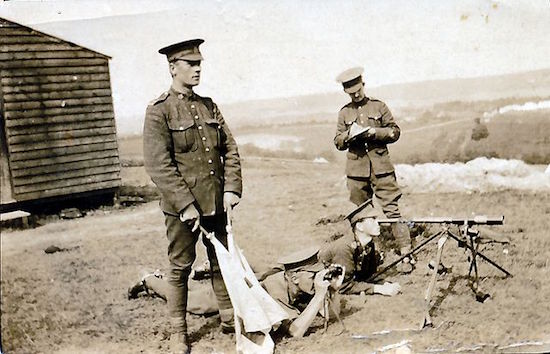
His neck will get pretty sore if he keeps that up...
*Old-School Telescopes and How to Get More Out of 'Em*
By: GVI
29 September 2021
There are all kinds of modern, high-quality roof-prism and porro-prism binoculars and spotting scopes available to anyone with deep enough pockets, and those with a hobby or profession that needs good optics will pay whatever the market will bear. Contrariwise, the non-specialist user can usually get by with any old glass from the sporting goods store. If the most an optic will do is sit around waiting for the next tractor pull or NASCAR qualifier, a $20 pair of pocket binos from the Bass Pro clearance bin is as good as a $350 pair of Hensoldt artillery binos - Billy-Bob-Lunchbox and Mary-Sue-Hairnet will never need the additional utility or quality.
For those of us who have a certain eye for aesthetics, the binoculars of the common, black rubberized type are about as soulless as modern pistols. Like modern pistols, they may be extremely good; but to quote Marie Kondo, "they don't spark joy." Binos and telescopes of an older style, on the other hand, do have a sort of personality, and you've seen me talk about one pair of binos which, sadly, is no longer available.
A new telescope just arrived at Chez GVI last week. It's marketed as a "nautical" telescope but that's not what it's modeled after.
https://www.amazon.com/gp/product/B06X9YHZMD/ref=ppx_yo_dt_b_asin_title_o00_s00?ie=UTF8&psc=1
I've moderately modified mine - you'll see in the photos that follow...
Rather, it is a mashup of two British army telescopes made between the late 1800s and the 1920s or so. Great Britain had a reputation for good glass at the turn of the 20th century which is comparable to that of the Germans in the mid-20th and the Japanese in the late 20th century. The one you see at the link follows the example of telescopes made for the British Army for use by semaphore/heliograph signalers and sniper/observer teams. It's what you'd get if you mixed the Mk VI Signaling telescope with the "Scout Regiment" telescope. You can look both types up.
I have a second, older telescope of unknown origin which I picked up at an antique store for maybe $20.00 several years ago. It's at least half-again as large as the former, but not so large as to be unwieldy to carry or to use.
I can't really make a case for old-fashioned "draw" type telescopes over and above more modern optics. It's just one of those things where you either like them or you don't. They were used into the 20th century because it was easier and much less expensive to make a high-quality telescope than it was to make a pair of binoculars or reflecting spotting scope of equal quality. Nowadays they're just curiosities.
Their principal drawback is how tiresome it is to hold them up to your eye for anything longer than ten seconds or so. There are plenty of astronomy telescopes with tripods; but like good optics, good tripods cost real money. The original telescope upon which the one I just got was based was often issued with any of several different tripods, sometimes more than one.

His neck will get pretty sore if he keeps that up...
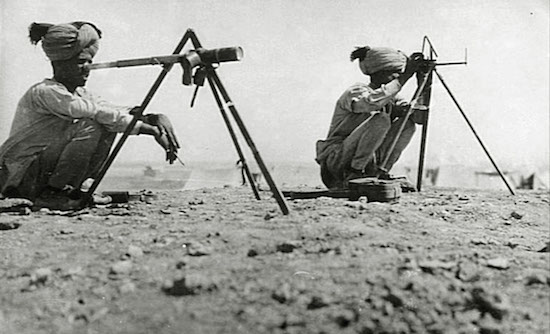
It's a trick of the camera - he's not really sticking his nose in the telescope.
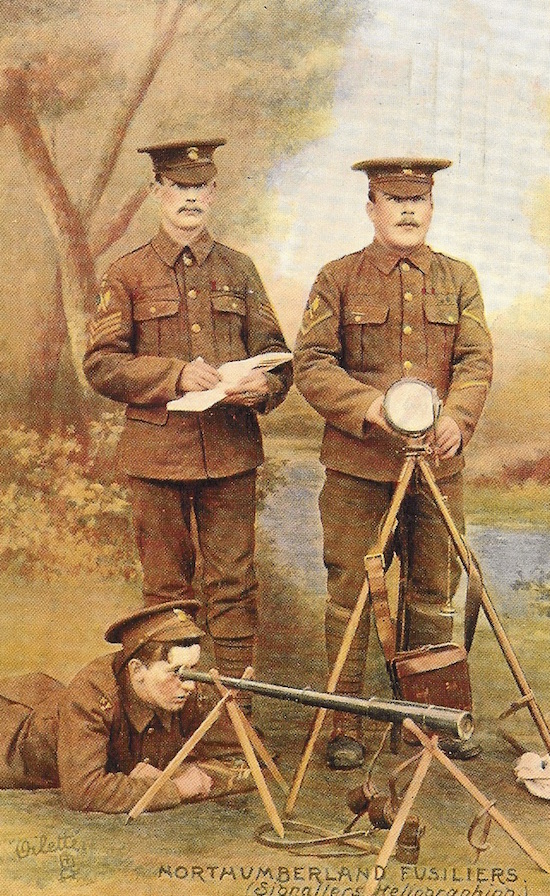
Posed studio photo - we'll come back to this one in a bit.
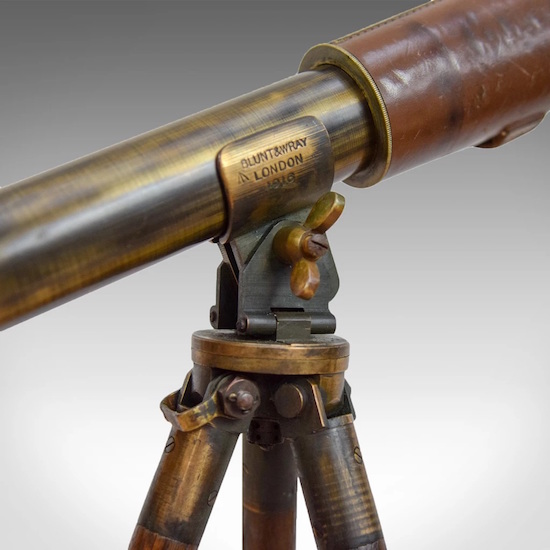
A pretty intuitive and simple mount
The single tripods were conventional affairs whose mount clamped the telescope at its "balance point" with a wingnut. A clever machinist could probably make a mount like this one, adapted to a good camera tripod, with relative ease, but I'm neither clever nor a machinist. The number of ways a store-bought camera tripod could be pressed into service is limited only by one's own ingenuity and industriousness.
Being fundamentally lazy, I took my hint for a pair of tripods from the posed and retouched photo of the Northumberland Fusiliers
At first glance it looks like the observer's telescope is perched on three tent pegs lashed together. A closer inspection reveals that this is not the case. The supports are in fact purpose-made, simply but cleverly. I didn't have a good version of this image when I first tried to use sticks to fashion two tripods in this manner, for which reason my first attempts, shown below, were wholly unsatisfactory.
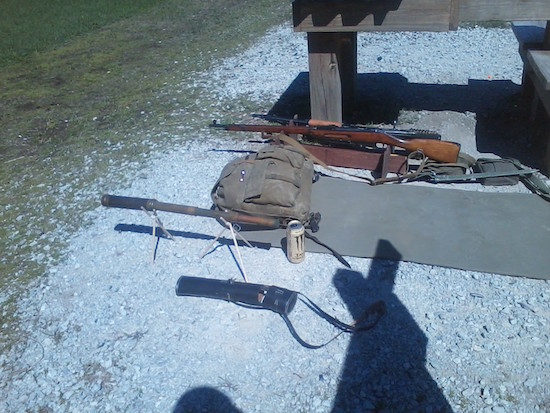
These things make good spotting scopes if only you can keep 'em steady...
What you see in the photo above is the older telescope, perched precariously on some sticks I've tied together using a tripod hitch with some twine. It looks like it's pretty stable but it's not - the sticks would constantly splay out under the weight of the telescope and it was a pain in the butt.
Just a day or so ago I tried the exact same thing, only subsituting artificial sinew for the twine, going over the whole thing with beeswax to get it to hold on tighter. Hold on it did, but the sticks would still collapse under the telescope unless they were stuck in anything less than horseshoe pit clay. I got a passing grade in Statics and Dynamics, so I should have known why - I have no one but myself to blame.
I knew the arrangement would work, but I was at a loss as to how. It wasn't until I took a closer look at a better version of the "Fusiliers" image above that I realized where the fault lay and how to remedy it. Look carefully and you'll see that the "sticks" are not set up as a tripod such as you'd contrive for a campfire. Instead, it's two legs hinged crosswise, with a third leg folding out away from them.
This was all the hint I needed.
Rather than set up the tripod with all sticks even, begin by backing the middle one down until it's about 3/8" above the tripod hitch, like so:
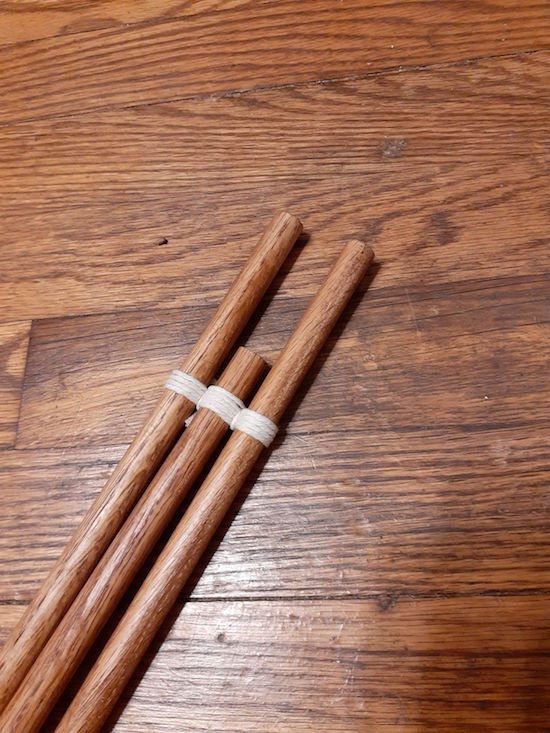
This simple arrangement is the key to making the whole thing work
Then push the center one away from the outer two, cross the outer two sticks over the center stick, and plant it firmly - see the next photo.
This allowed me to set the tripods up in a manner identical to that shown in the photos and - whaddyaknow - it works perfectly!
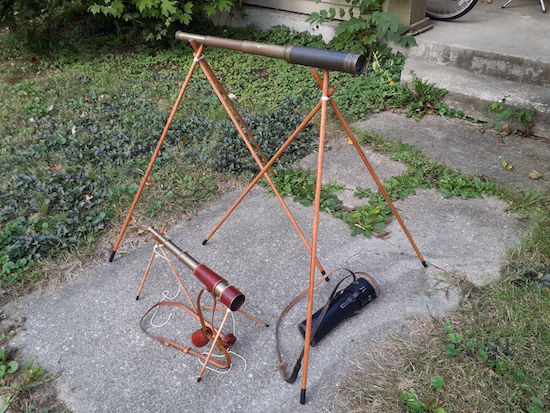
There is a set of tripods in the black scope case beneath the large scope. It's not shown because why bother - it looks just like the short one!
It still takes a bit of fiddling to get everything right. There should be tension in the hitch when the three legs are splayed out - the tripod should feel like it's trying to resist being spread out thus. If this tension is not present, the weight of the telescope will collapse the tripod. The fix is to swing the center leg the other way and re-attempt - you'll feel tension in the hitch one way but less or none the other way.
The question of how high to make the tripod depends on one's intended use. If you're prone as the Fusiliers are (or as I was when at the range), a tripod made of 10-12" sticks like those shown is satisfactory. If you wish to sit up while using the telescope - or you can do the "Asian squat" like the Indian signalers (I can't) - then make the two tripods about 3-feet tall or so. I'm short, so a tripod with 3-foot long legs gives me the option of sitting on the ground or - if set up more narrowly - using a short folding camp stool. They're cheap enough so why not make one of each size?
If you want something you can stand up using, either buy a dedicated tripod and get a mount of some sort, set a smaller tripod on a truck hood or something, or else pick up a "shooter's rest" monopod that has a forked top for the rifle forend - they're cheap and they'll hold a telescope up just as well as a gun.
You can of course use any old sticks you find laying around, but I still recommend making your own. If you're somewhere where there are sticks everywhere, then you're usually somewhere where lines-of-sight aren't long enough to merit a telescope in the first place, or else there are plenty of trees with low branches to rest the scope on. Conversely, if you don't have such trees to use as rests, you won't have sticks lying around either. It's been my experience that the moment you decide to rely on nature's bounty to provide something like the right size sticks for you on-site, you're either going to find yourself in someplace like Mongolia (where there are no trees anywhere at all outside the taiga forests of the North) or else the only thing you can get your hands on is willow branches.
In other words, don't depend on finding something when you get where you're going - be a grown-up and make what you need beforehand. I used dowel rods for mine. My choice of 1/4" dowel for the short tripods was dictated by how much room I had in the telescope's case for them, and how long the case itself is. The longer tripods are made from 1/2" poplar because these telescopes aren't heavy enough to merit oak or hickory, both of which are stupid expensive at the time of writing.
I stained the sticks with "teak" colored stain because why-the-hell-not, and rubbed some beeswax on the "outer" sticks where the tripod hitch goes. The center one has no beeswax because it must slide up-and-down easily. Common twine is used in all cases because the center stick will slide well on it but still hold tight, and you can get the stuff anywhere. You could whittle the tips to a point or add metal spikes of some sort on the end, but I chose to Plasti-Dip mine because I may want to set them up on a paved surface; and as any surveyor will tell you, pointed tripod legs DON'T play well with concrete.
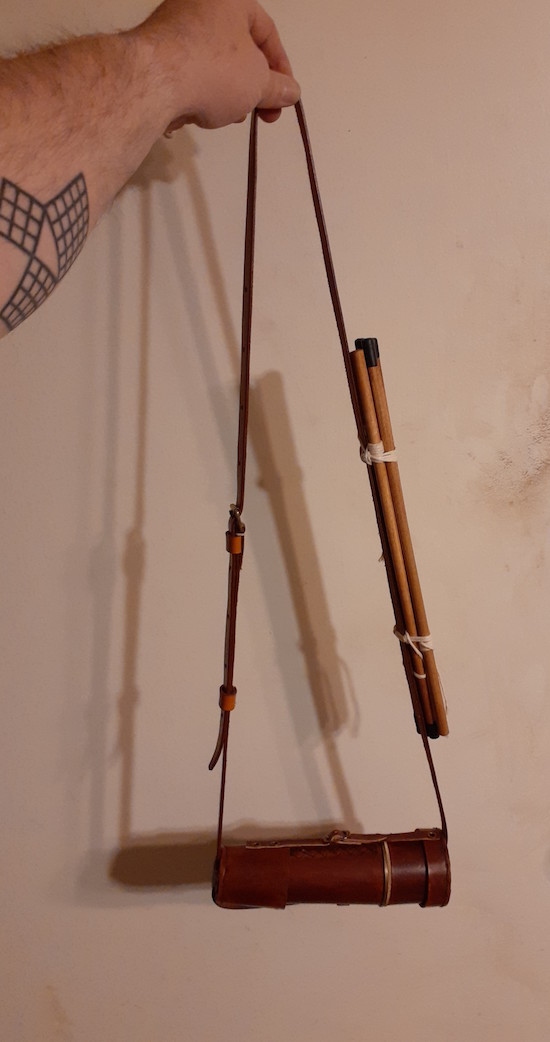
My "Scout Regiment" telescope, re-stained, new strap, cannibalized original strap holding the end caps, with short legs stowed.
The original crummy color would work well in the African Savannah, the Badlands or the Eastern Front.
As for those of us who want to hold binos up with something more stable than their wrists or elbows, this image is instructive - I suspect even I could make something like this out of a block of wood, a velcro strap and a metal screw-thread insert.
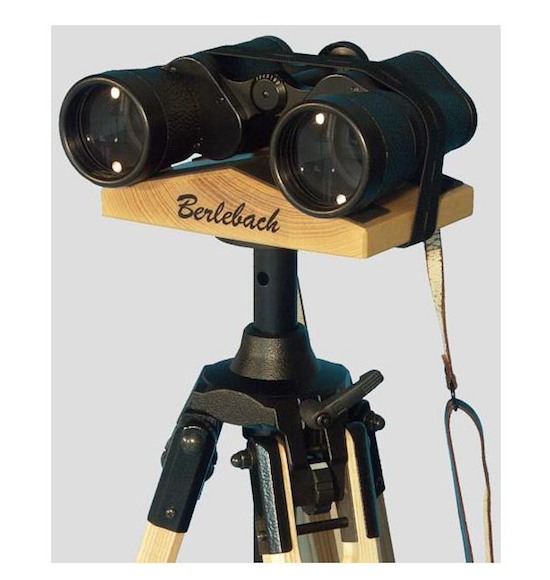
So simple even I could make it
I could probably count the number of people who can make use of this information on one hand and still have enough fingers left to play banjo. I shared it because I enjoyed knocking the things together, it's easy, it's effective, and it plays to the aesthetic many of us seem to be fond of.
GVI
www.alpharubicon.com
All materials at this site not otherwise credited are Copyright © 1996 - 2021 Trip Williams. All rights reserved. May be reproduced for personal use only. Use of any material contained herein is subject to stated terms or written permission.